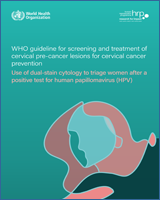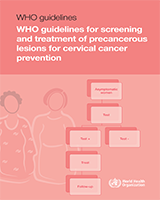Introduction
This document includes the judgements and evidence for each recommendation as presented and used by the Guideline Development Group to make recommendations for the WHO guidelines for screening and treatment of precancerous lesions for cervical cancer prevention.1
In each section and for each recommendation, we provide:
recommendation and remarks, which relate to the strength of the recommendation and the quality of the evidence;
an evidence-to-recommendation table, describing the judgements made by the Guideline Development Group;
evidence for each recommendation, including:
- –
flowchart for the screen-and-treat strategies that were compared;
- –
evidence used for decision-making:
diagnostic test accuracy evidence profile;
GRADE evidence table for patient-important outcomes following different screen-and-treat strategies (based on model);
GRADE evidence table for patient-important outcomes following different screen-and-treat strategies by age.
- –
references.
Acronyms and abbreviations
- ASCUS
atypical squamous cells of undetermined significance
- CI
confidence interval
- CIN
cervical intraepithelial neoplasia
- CKC
cold knife conization
- colp
colposcopic impression; women who have abnormal results on colposcopy would not be treated
- cryo
cryotherapy
- cyto
cytology, Papanicolaou test (using conventional or liquid-based cytology); cut-off for screen-positive test is ASCUS
- DTA
diagnostic test accuracy
- FN
false negative, calculated from sensitivity of screening test; women who receive FN screening test results will not receive the treatment they need (because their positive status was undetected)
- FP
false positive, calculated from specificity of screening test; women who receive FP screening test results will receive unnecessary treatment
- GRADE
Grading of Recommendations, Assessment, Development and Evaluation
- HIV
human immunodeficiency virus
- HPV test
human papillomavirus screening test; cut-off for screen-positive test is 1 pg/mL
- HPV➔VIA
a sequence of screening tests in which an HPV test is followed by VIA; the HPV test is used first and only those women who screen positive for HPV are screened with VIA as a second screening test; women who screen positive on VIA are then treated, while women who screen negative on VIA are not treated
- HPV +/− CKC
strategy in which an HPV screening test is used and screen-positive women are treated with CKC, but screen-negative women are not treated; it should be noted that all screen-and-treat strategies follow this format (also HPV➔VIA +/− LEEP)
- LEEP
loop electrosurgical excision procedure (also LLETZ, large loop excision of the transformation zone)
- QoE
quality of evidence
- QUADAS
QUality Assessment for Diagnostic Accuracy Studies
- TN
true negative, calculated from specificity of screening test; women who receive TN screening test results will not receive treatment and do not need treatment
- TP
true positive, calculated from sensitivity of screening test; women who receive TP screening test results will receive the treatment they need
- VIA
visual inspection (of the cervix) with acetic acid; can be used (i) as a cervical screening test; or (ii) to assess whether a patient is eligible for cryotherapy


